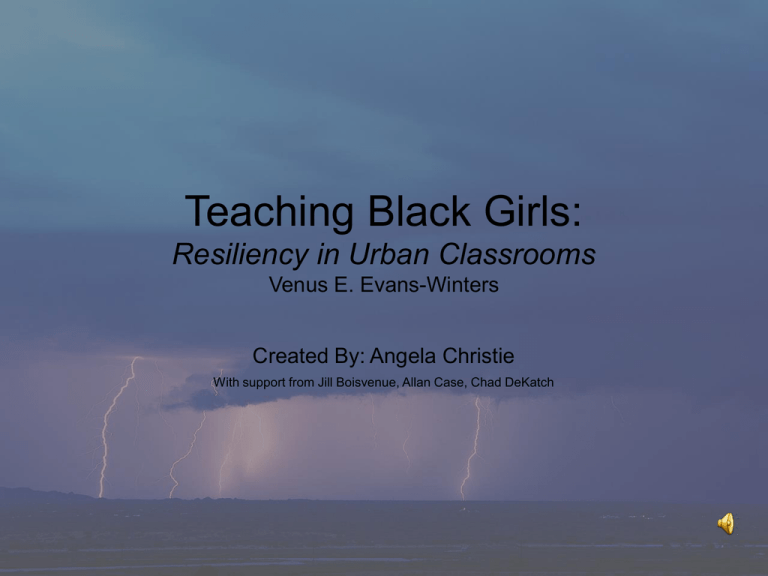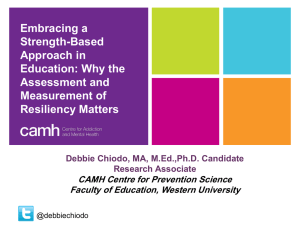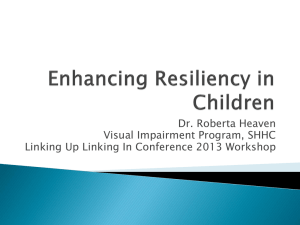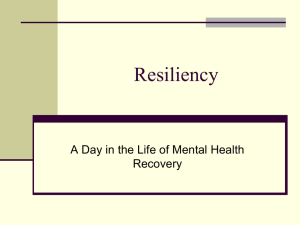Teaching Black Girls - Angela Christie
advertisement

Teaching Black Girls: Resiliency in Urban Classrooms Venus E. Evans-Winters Created By: Angela Christie With support from Jill Boisvenue, Allan Case, Chad DeKatch Focus “Teaching Black Girls focuses on how students succeed and focuses on resiliency and resiliency-fostering factors in the lives of three Black girls, growing up and attending school in an urban neighborhood.” (Evans-Winters pg. 4) Why this focus? • “Current theories of development, intelligence, curriculum, and pedagogy have been devised from the experiences of what has been discovered to be best for White middle-class boys.” (Evans-Winters pg. 7) • “African American girls were also absent from the school resiliency literature….not many research studies were available that focused on the positive outcomes of African American girls.” (Evans-Winters pg. 3) Evans-Winters suggests “There are several reasons why Black female adolescents are absent from the literature. Compared to black males, black females have fewer behavior problems. African American girls’ behavior are least likely to affect others; thus research and the resulting reform efforts tend to focus on Black males. Another factor is that White women have dominated the women’s movement, which means their research is conducted on themselves or white adolescents. Last, researchers tend to assume that white females and Black females have similar socialization processes…By ignoring or subsuming Black girls’ experiences within White girls’ or Black boys experiences, we overlook the inimitable experience of the Black girl.” (Evans-Winters pp. 9-10) Ethnography Evans-Winters major arguments are that AfricanAmerican girls have largely been ignored as a focus of study within resiliency research and that through her research she demonstrates a confluence of factors that contribute to this resiliency – including discussion of the oppressive simultaneous interaction of racism, classism, and sexism that create the need for resiliency – juxtaposed with the support mechanisms of community, individual action, and education as a means for social change. Theme Reflection When conditions are right, i.e. stressors and supports are amenable to each other, a power exists that a person can take the stressor experience and learn from it to create a positive change in their being. This power is referred to as resiliency. Common application of Resiliency • In respect to objects, resiliency is defined with relationship to buoyancy; having the ability to bounce back to its original state after encountering adversity or obstacles. • In respect to social behavior, resiliency is defined as “successful adaptation despite risk and adversity.” (Evans-Winters pp. 110) Resiliency in terms of Teaching Black Girls Evans-Winters discusses resiliency in terms of the oppressed female African American culture. Her theme reflects an adaptation of the definition of resiliency and from a Black feminist standpoint. She highlights that, “after living through and recovering from a stressful or traumatic experience, the goal may not be to return to its original state, but to learn from experiences from stressors and to adopt a new state of consciousness.” (Evans-Winters pp. 110) Metaphorically Speaking Consider resiliency in people or more specifically, African American girls to the resiliency in sand. When sand is struck by lightning in the right conditions it is not ruined, but transformed from its original state of being to a new an improved state of being. This new state is stronger and even more beautiful with new uses and benefits. “Mother Nature makes glass each time a large amount of energy is released during a sufficient period of time at the Earth's surface, provided that the soil composition is suitable for making glass…Glass (a glassy object, to be exact) that is made as a result of a cloud-to-ground lightning discharge is called a fulgurite (from the Latin "fulgur" which means lightning). Fulgurites come in a great variety of forms and can be viewed as nature's own works of art.” Vladimir A. Rakov, PhD. "Petrified Lightning from Central Florida," (1997-1998) http://home.att.net/~allanmcnyc/rakov.html Perspective From this perspective of resiliency we question: • What are the resiliency-fostering factors that are necessary for success of African American girls? In other words… • What are the lightning bolts or stressors that can negatively impact Black girls to deter them from success? • And what are the right conditions or support that is necessary to bring out resilience and in turn create a positive transformation? Framing the perspective “We need a framework in order to understand how structural forces and context-specific social conditions negatively and positively influence schooling experiences…the need for theory-building that has practical implications for curriculum, policy, and pedagogy.” (Evans-Winters pg. 11) Stressors versus Support “African American communities do have a tradition of supporting education,” (Evans-Winters pg. 28) so we must first look at what the stressors are and where they come from. Evans-Winters addresses the historical context of structural and social implications in the lives of Black girls because she has found that, “the most competent and resilient minority female students possess a race, class, and gender consciousness.” (Evans-Winters pg. 44) Race, Class, and Gender in Support of Education “This study reminds educational researchers to consider the interconnectedness of individual agency, community forces, and larger social structures and, in addition, the aforementioned effects on students’ school experiences and outcomes…African American students’ frame of reference reaches beyond the ghetto.” (Evans-Winters pg. 33) Resiliency in Context Resiliency is fostered through several interweaving factors and that many explanations for resiliency are exceedingly simple in their diagnosis and do not take into account individual accounts. Such grand narratives do not examine the local levels of consciousness and the support generated by the confluence of individual, community, and society. Evans-Winters addresses the racial marginalization of African Americans in the drafting of the constitution which set a precedent for today’s institutionalized racism. “White supremacy predated the Constitution, but the moral compromises made in the Constitution and the justifications of those moral compromises solidified White supremacy in the minds of White Americans.” (Evans-Winters pg. 24) She then addresses several theories that fail to take context into account and addresses the phenomenon of many Black girls being taught by White teachers. The explanation of the binary uses of the non-contextual theories and their oversimplification through grand narratives that don’t account for individual experience are amplified. EvansWinters reminds the reader that interconnectedness is imperative when examining resiliency and that binaries and modernist perspectives discount this complexity through oversimplification. She goes on to discuss resiliency in greater detail and credits a “dual conscious,” in itself a binary, as a major factor to resiliency in Black girls. Resiliency in Context cont. Evans-Winters explains the path of the social context of the subjects which she is later going to be working with. Her study took place in a town she called "Haven." In Haven, the community has dealt with much segregation and desegregation issues overtime. EvansWinters looks, “at the historical practices that have contributed to the social inequality between Haven's African Americans and European Americans and threatened the educational resiliency of Blacks." (pg. 52) The social inequality trends between 1940 and 1990 have contributed to continued lack of rewards, opportunities, and mobility factors found still today. With all of this research as a foundation, "...we begin to look at what supports to African American female students buffer the possible negative outcomes associated with race, class, and gender inequality." (Evans-Winters pg.66) Evidence The ethnography Evans-Winters conducted was framed with the notion that “we have to look at how larger historical forces and social structures affect [black girls] families, communities and schools as their individual choices” (Evans-Winters pg.23) “The six students [chosen] were viewed as resilient because they were aware of how race and class (and in two cases gender) affected their education and career opportunities but nonetheless were high achieving and optimistic about their life chances…resilient students do not wholeheartedly believe in the dominant ideology of making it and are race, class, and/or gender conscious.” (Evans-Winters p.35) Nicole, Zora, and Yssis Evans-Winters writes of each of these girls experiences and tries to understand the relationship between the girls' resilience and their families, schools, and communities. Each girl has their own story but a common theme between each of them is obvious. In some way, shape or form their success can be traced back to outside factors. In Nicole's case, her family is one of her biggest support systems despite the fact that she was raised by her grandmother, "What is central to Nicole's educational story is that she completely redefines the traditional notion of family so it fits her idea of family support." (Evans-Winters pg. 93) In Zora’s case, school may not have been the most interesting place for her, but she excelled in extracurricular activities. JROTC provided her with an opportunity to prove herself as a leader and furthered her education. "In Zora's case JROTC may be a strong factor in her character building, in turn, fostering educational resilience." (Evans-Winters pg. 113) In Yssis’ case, she knows that her community is not the best place to find role models but uses that to her advantage. "Yssis is very conscious of the lack of resiliency portrayed by individuals in her community. Thus, she has made a conscious decision not to be actively involved in her immediate neighborhood." (Evans-Winters pg. 126) From the Field Through the ethnography, Evans-Winters states that she has a different view of resilience from most scholars and researchers: She states that she is “observing and theorizing from a unique standpoint, which allows [her] the opportunity to view resiliency in its various states.” (pg. 132) She has witnessed resilience in: • Teenage mother who decides to leave school and seek out paid labor with the hopes of providing adequate childcare for her child. • Pooling resources in a group of women living together. • Toughing it out in a hostile learning environment with hopes of improving one’s chances in life. She narrows the focus of resilience to: • African American female students and its application to the school environment. • “Out” former educational research and in the end, “confront more pressuring issues like equal educational opportunities for adolescent mothers.” (pg. 132) She proves resilience in terms of: • The stressors of race, class, and gender are intersecting and cannot be separated into different divisions or categories that differ widely from or contradict each other. – Evans-Winters (pp. 131-132) What We’ve Found: Stressors vs. Supports •Single/low-income families •Family-caring female role models •High crime/poverty neighborhoods •Community programs that complement education •Underfunded schools •Racism, sexism, classism •School provides extracurricular activities and academic support •Goal oriented •Grades are important •Participation in school activities •Low mobility •Seeks help and resources The impact of context on educational experiences: The bidirectional flow of stressors, supports, and qualities of resilience. (Evans-Winters p. 133) So Now What? How can we use this information to assist in recognizing and supporting the resiliency in the teaching of Black girls? Support Systems Family, community, and school support are directly related to school resilience. All three aspects need to be available for students to draw from simultaneously in order to “buffer adversity.” (Evans-Winters pg. 135) Most resilient student’s were “more adept at blurring the boundaries between family, community, and school.” (Evans-Winters p.136) Family Support In Terms of the Resilient Black Female Student: Any family member who is a main source of support – Generally a female caregiver who fits into the category of “main support” – Does not necessarily need to be a biological parent, or even a two parent, heterosexual living situation – Provide a sense of love and care that show that the student’s educational accomplishments are important – Support or assist in completing homework assignments or studying for tests – Monitor school participation Community Support In Terms of the Resilient Black Female Student: – Offers temporary job opportunities – DCFS (Department of Community and Family Services) – Provides mentors – Provides programs that offer some type of direct or indirect support to students’ families. – Provides gender specific activities – Provides a safe space School Support In Terms of the Resilient Black Female Student: – Provides extra curricular activities that support long term goals – Provides at least one adult whom the student feels positive about – Provides tutoring/academic assistance – Provides stern but understanding teachers Self Support In Terms of the Resilient Black Female Student: Individual Student Intentions and Motivations THE STUDENT: – – – – – – – Has a “plan” Looks forward to completing high school Develops a long-term plan in “life” Long-term career goals College plans and hopes Conscious of grades in school Consciously chose friends who were not associated with their neighborhood Resiliency Knowing and understanding what support systems are necessary to bring about resiliency and create success, as educators, we need to assist our students in finding these support systems, providing these support systems, and using these support systems to offset the negative implications in their life, so they can achieve their utmost potential. In Summary When lightning strikes sand in the appropriate conditions the sand particles are welded together to create a stronger, and in some perspectives, more beautiful structure. The resiliency the sand has exhibited when being struck by lightning and taking the opportunity to change by bonding together instead of dissipating is only a metaphorical comparison to the resiliency in terms of African American girls and their success in society. Evans-Winters has proven that while much research still needs to be done to find more concrete answers to the notion of resiliency in urban classrooms, the foundation exists that when African American girls can find the right support conditions to be resilient to the obstacles they face, success can be achieved. References • • Vladimir A. Rakov, PhD. (1997-1998). Petrified Lightning from Central Florida. Retrieved February 17, 2007, from http://home.stt.net/~allanmcnyc/rakov.html Evans-Winters, Venus E. ( 2005). Teaching Black Girls: Resiliency in Urban Classrooms. New York: Peter Lang Publishing, Inc.









